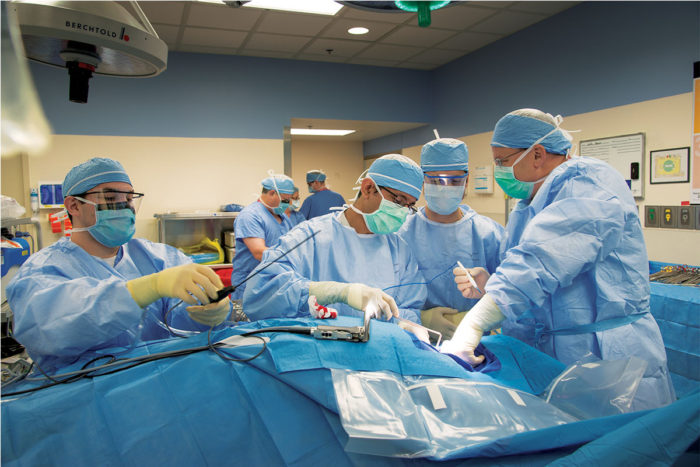Treatment options for high-risk lung cancer patients
Doctors at Barnes-Jewish Hospital and Siteman Cancer Center are comparing radiation versus surgical treatment in high-risk lung cancer patients

Traves D. Crabtree, MD, right, and Varun Puri, MD, center, work with a surgical team to remove a tumor.
An unusual collaboration among Washington University radiation oncologists and thoracic surgeons at Barnes-Jewish Hospital and the Alvin J. Siteman Cancer Center has led to a more scientific approach in assessing treatments for early-stage lung cancer patients who are too sick to have a lung removed. Ultimately, their research may lead to definitive guidelines in the treatment of this vulnerable patient group.
For patients with early-stage lung cancer who are healthy enough, surgical removal remains the gold standard. At the other end of the spectrum are patients who are poor operative candidates and are best suited for stereotactic body radiation therapy (SBRT), which delivers precisely targeted radiation to a tumor. The goal of the Washington University specialists is to establish criteria for patients who are high risk, yet would be considered for either SBRT or sub-lobar resection, removal of a portion of the lung.
“Currently at our institution, medically inoperable or extremely high risk patients are presented at a multidisciplinary tumor board with radiation oncologists, surgeons and radiologists, and we review the cases and make a judgment about who would be a surgical candidate and who would not,” says Traves Crabtree, MD, a Washington University thoracic surgeon at Barnes-Jewish Hospital. “The process needs to be more objective.”

To date, the thoracic surgeons and radiation oncologists – representing specialties that elsewhere often have a competitive relationship – have worked together to complete three retrospective studies comparing the clinical effectiveness of SBRT and surgery in patients with stage I non-small cell lung cancer. Another retrospective study looked at the cost of SBRT versus surgical intervention in the same category of patients.
The clinical studies, drawing on either Washington University cases or national databases, found that overall survival was better with surgery. However, in the often contested and controversial high-risk patients, cancer-specific survival was similar between SBRT and surgery. The cost analysis study found that surgery appeared to be slightly more cost effective than SBRT.
New areas of research
Crabtree and Jeffrey Bradley, MD, the S. Lee Kling Professor of Radiation Oncology and a radiation oncologist at Barnes-Jewish Hospital, note that the retrospective studies have a selection bias because patients were selected for a particular treatment and not randomly assigned to surgery or SBRT. “We can try to address this selection bias with statistics, but we cannot completely overcome it,” says Bradley. “Randomized comparisons are needed to compare the two treatments.”
A prospective trial started a year ago by the Alliance for Clinical Trials in Oncology and the Radiation Therapy Oncology Group that would have randomly assigned patients to SBRT or surgery failed to accrue enough subjects, but organizers are working to redesign and reopen the trial, an effort the Washington University group supports.
A long-term goal is to develop an algorithm that would use criteria such as lung and heart function to determine mortality and other factors related to each treatment. But researchers must first overcome an obstacle: Although data needed to develop such an algorithm are available from the Society of Thoracic Surgeons (STS) National Database regarding surgical patients, there is no source for comparable statistics from patients deemed inoperable. Future plans include adding such patients.
To take a closer look at how researchers categorize patients, Crabtree and Varun Puri, MD, a Washington University thoracic surgeon at Barnes-Jewish Hospital, have reviewed national trials of early-stage lung cancer patients undergoing SBRT or surgery and found many of the studies used relatively loose criteria to define high risk. Further research is being planned to use the STS database to develop a risk model for patients being considered for surgery.

Thoracic surgeon Varun Puri, MD, is developing risk models to predict lung cancer survival rates.
Puri also is developing risk models to predict long-term survival and long-term cancer-free survival rates for patients with early-stage lung cancer undergoing surgical resection or SBRT, factoring in individual characteristics. The statistical models will be based on Washington University data and use data from Memorial Sloan-Kettering Cancer Center and Cleveland Clinic for validation.
Quality of life
To determine the most appropriate treatment for early-stage lung cancer, physicians must also consider patients’ quality of life.
Thoracic surgeon Stephen Broderick, MD, developed an interest in patient experience during his cardiothoracic surgery fellowship and is leading a project to measure this through validated quality of life, social support and depression scales.
“It’s one thing if patients are returned to their pre-treatment quality of life and live for five more years,” says Broderick. “But if they are not able to carry out activities of daily living, then perhaps we may need to rethink some of our treatment paradigms.”
“Continued work in this multidisciplinary collaboration will add important knowledge and insight to improve our ability to get the safest and most-effective therapy to patients, and to improve our ability to measure and improve outcomes,” says Bryan Meyers, MD, MPH, Patrick and Joy Williamson chair in cardiothoracic surgery and thoracic surgery section chief.







